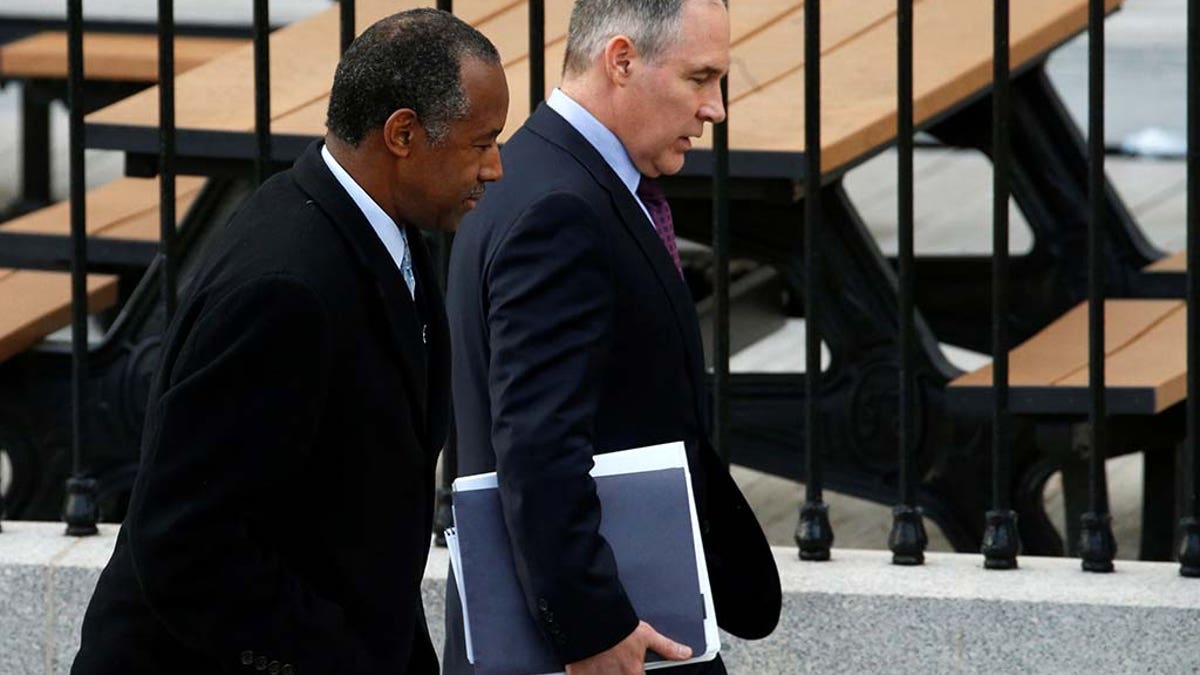
HUD Secretary Ben Carson and EPA Administrator Scott Pruitt are among the tiny fraction – 2 percent – nominated by President Trump of the 1,200 mostly senior executives who will be needed to run more than 200 federal agencies. (REUTERS/Jonathan Ernst)
To reduce the harsh noise level surrounding his fledgling administration, President Trump needs to do something difficult: not squelch his critics but focus like a laser on staffing the upper reaches of his federal bureaucracy.
A good place to start might well be the vetting and personnel teams inside the White House.
Given the enormity of the executive establishment, it is not surprising that there are different responses to the new president, and that some of them get aired. Employees in Immigration and Customs Enforcement were obviously delighted by his election. The response in the State Department, the Environmental Protection Agency and the National Park Service was decidedly less enthusiastic.
To date, however, Trump has only nominated a tiny fraction -- 2 percent -- of the 1,200 most senior executives that will run more than 200 agencies of the federal government. Even fewer -- 1 percent -- have been confirmed. Without his team in place the president obviously lacks the ability to effectively manage the 2.8 million federal employees scattered across the nation and globe.
Surprisingly enough, just doing that hiring could well put a lot of the bureaucracy at ease.
It is true that ideology plays a role in this bureaucratic friction, but human nature also plays an important part.
Federal employees are like everyone else. They have views about what government should and should not do. Prospective government employees often choose government work because they support what government is doing. Environmentalists are more likely to work and stay in the Environmental Protection Agency and law and order types are more likely to run the Drug Enforcement Administration, for example.
When the views of the new president and continuing government professionals clash, career civil servants respond in predictable ways. They have often put the policies of previous administrations into place -- the regulations, the budget requests, and the enforcement priorities. While civil servants pride themselves on being able to serve Republicans and Democrats equally well, many have very human responses when a new president takes office with a vow to shake things up.
But at the moment, the vast majority of government workers have no one speaking to them on behalf of the president with the authority that comes from confirmation in office.
No one has explained the vision of the new administration for their agency. Their boss has not yet told them that they are valued and that the new administration can work productively with them. No one has expressed to them the administration’s confidence that all the career civil servants will do their professional duty to support the new president.
And, no appointed leadership team is in place to take control of the levers of administration such as communications, budgeting, personnel and legal affairs.
The result is predictable: fear, uncertainty and higher levels of resistance.
We fixate on getting Cabinet secretaries nominated and confirmed, but this hardly matters at all in the broader scheme of things. People forget that the Cabinet agencies are enormous and complex organizations, with many more leaders below the top individual.
Consider, for example, the Department of Health and Human Services. It employs more than 80,000 people across a dozen agencies. While President Trump was pleased to tweet about the confirmation of Tom Price as the new secretary, there are 17 other Senate-confirmed positions in the department.
No one has yet been confirmed to run the Centers for Medicare and Medicaid Services, the agency most responsible for implementing the Affordable Care Act (and Medicare and Medicaid). Similarly, the president needs to select heads of the Food and Drug Administration and National Institutes of Health.
There are also 55 to 60 independent agencies outside the Cabinet structure waiting for leadership from the new president. These include agencies as important and diverse as the Office of Personnel Management, (the government’s human resources agency), the National Aeronautics and Space Administration and the Social Security Administration.
In all of these places, civil servants worry about what the new administration wants without the help of new bosses who can separate fact from fiction.
The confirmation process has not been easy so far, but the contentiousness of the top nominees should not be an excuse for delay for less visible nominees.
The president can still ramp up the selection and vetting at the White House and set ambitious targets for filling out his senior team. In addition, the Senate historically has been more deferential to nominees below the Cabinet level. With a Republican Senate and no filibuster threat, the president should have an easier time than earlier presidents at doing this.
And if the political opposition insists on digging in against every single appointment, public opinion is liable to become weary -- of them.
Atop that, the president and his team have 2,200 additional lower level political appointees that do not require Senate confirmation.
One reason for the chaos of the first month has been a thinly staffed transition and White House. This has contributed to delay in staffing the administration and the results have been predictable -- chaos and confusion.
It can, however be fixed: just do it.
